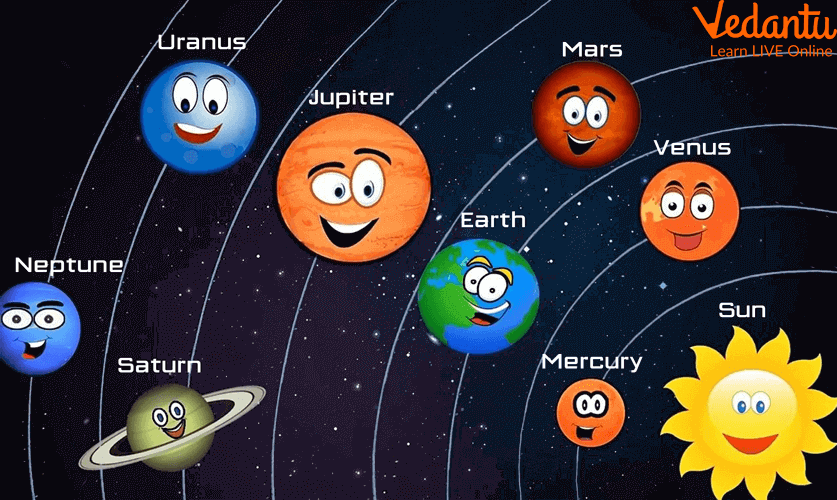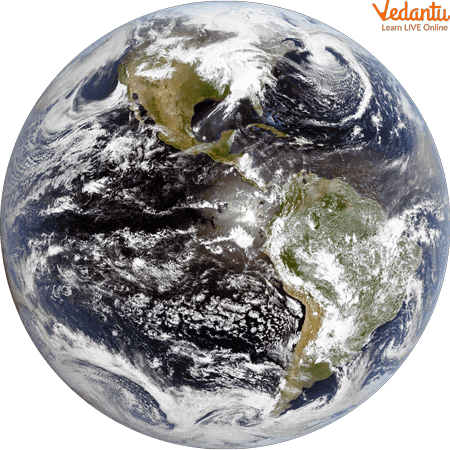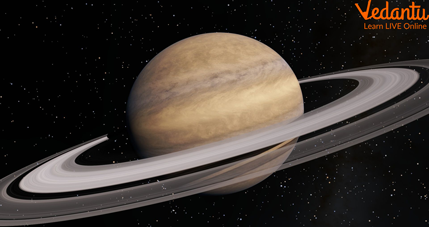




What are Planets?
Have you ever wondered what planets look like? Let us study the solar system and all the planets out there. The large objects that orbit around the sun are known as planets. Earth is a small planet in this vast unending Universe. There are seven other planets in the solar system apart from our planet Earth. Our solar system is a part of the galaxy called the ‘Milky Way.
The solar system is also home to the Sun, the Moon, Stars, Meteors, Galaxies, etc. All the planets revolve around the Sun through their orbits. Some planets have their satellites, some planets have rings, some planets are made of gas and some are made of rocks. In this article, we will talk about planets in order for kids and facts about each planet one by one.

Solar System
Mercury
Mercury is the smallest planet in the solar system. Mercury is the hottest planet in the Solar System because it is the closest to the Sun. Mercury takes 88 days to complete one round around the Sun. It is almost impossible to go near Mercury as it is like a huge ball of gas.
Venus
Venus is the second planet in the Solar System from the Sun. It is Earth’s neighbour with Mars. It is the only planet that spins in the opposite direction to all the other planets in the solar system. It is also very hot and the temperature can rise to 450 degrees Celsius. Venus is covered with volcanoes and takes 243 earth days to complete one rotation.
Earth
Earth is the only planet that has life, air, water, human beings, animals, plants, etc. Earth is the third planet and is unique in nature. It takes 365 days to complete one revolution around the Sun. It also takes around 24 hours to finish one rotation which results in day and night. The satellite of Earth is called the Moon. Earth is our home and it is the only planet suitable for life.

The Earth
Mars
Mars is fourth in number to the Sun and is another neighbour of the Earth. It is called the Red Planet because its appearance is red from the outside. The temperature of Mars varies from extremely cold to extremely hot. Mars can be seen from the telescope as a red spot in the universe.
Jupiter
Jupiter is the fifth planet in the solar system and is also called the ‘Jumbo Planet’. It is the largest planet in the solar system and over 300 Earths can take place on its surface. It is made up of gases like helium and hydrogen and is also called a ‘Gas Planet’. Jupiter has 62 moons making it the most number of satellites. Jupiter is a gas giant planet. Galileo gave its first detailed description in 1610.
Saturn
Saturn is the sixth planet and is also the second largest planet in the Solar System. Saturn is made up entirely of gases. It is the only planet that has a ring around it and is called a ‘Ring Planet’. The ring of Saturn is made up of rocks and gases only. It is known for its beautiful rings around its equator.

The Saturn
Uranus
Uranus is the seventh planet and is also the second last planet in the Solar System. Uranus is the coldest planet in the system with an average temperature of -225 degrees Celsius. Uranus spins on its side, unlike all the other planets. Uranus experiences the nights for around 21 years with extreme winters.
Neptune
Neptune is the last planet in the Solar System. It is made up of ice particles only and that is why it is bright blue in colour. Neptune was named after the Roman God of the Sea and Neptune ends the solar family of the Milky Way. Neptune takes the longest time for one single revolution around the Sun as it is the farthest planet in the Solar System. It is the only planet that is not visible to the naked eye from earth. It is more than 30 times larger than the earth.
Summary
This article tells us about the planets in order for kids and also the facts about each planet. The mystery of the solar system is not resolved. Planet is a natural object. The planets in the solar system revolve around the Sun in their own orbits. They have their own satellites. The planets are placed at equal distances in the system. Some planets are extremely hot and some are cold. Some have rings while others do not. Some are made up of gases while others of rock. Among all, Earth is the only planet that has life on it. It is our home. I hope this article is beneficial for you. If there are any doubts please ask in the comments.
FAQs on Planets for Kids
1. What planet is white?
The planets of the solar system are varied in their appearance. Mercury is slate grey while Venus is pearly white, Earth a vibrant blue, and Mars a dusky red.
2. Which star is known as Morning Star?
Mercury may be seen as an evening "star" near where the sun has set, or as a morning "star" near where the sun will rise. The ancient Greeks called the evening star Hermes and the morning star Apollo, believing them to be different objects. The planet is named Mercury, the Roman messenger of the gods.
3. What gives a planet its colour?
Planets have the colours that they have because of what they are made of and how their surfaces or atmospheres reflect and absorb sunlight. Mercury has a dark grey, rocky surface which is covered with a thick layer of dust. The surface is thought to be made up of igneous silicate rocks and dust.
4. How does a planet differ from a star?
Planets differ from stars in many terms as stars are huge and made up of gases, they also have their own light whereas planets do not have their own light and reflect light from an external source.









